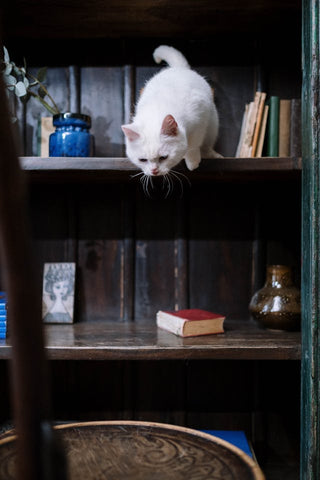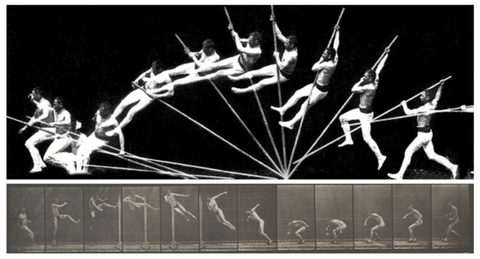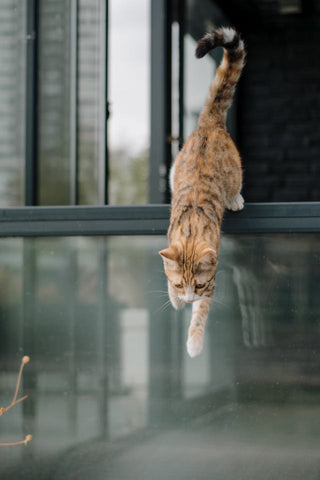Do cats land on their feet?

Cats are magical. Anyone who has ever loved a cat already knows that. But do they have special powers?
One of the seemingly mystical abilities attributed to cats is their apparent ability to land on their feet no matter which way they fall, and no matter the height from which they fall.
Is it true? Do cats land on their feet? And do they always land on their feet?
Spoiler alert: cats do have a special, innate ability to twist themselves right-side-up during a fall, that seems to defy the laws of physics. And there are documented cases of cats surviving falls from crazy, crazy heights.
Let’s talk about this special ability, and also a cat’s unique anatomy that can make not just turning upright during a fall possible, but surviving a big fall possible, too.
(Do cats really have 9 lives? Read this post to find out!)
Cats survive falls from incredible heights
Stories abound of cats surviving falls from heights that would most certainly kill a human. Here are some examples:
Six-year-old Gizmo fell 12 stories from this Manhattan apartment building, suffering only minor injuries, including a chipped tooth.[1]

Eight-year-old Sasha Fierce, a long-haired orange cat from Virginia, jumped from or fell off a 15th-floor condo balcony, and survived with just a scratched cornea from mulch that had gotten into her eye.[2]
And this black cat from Chicago was caught on video saving himself from a burning building by jumping five stories, and casually sauntering off afterwards.
Cats seem to defy the laws of physics
Falling cats have been puzzling scientists since the late 1800s, at least. No one was ever surprised that cats, daredevils that they are, would fall. But it was odd how they always managed to flip themselves over, mid-fall, so that they landed feet first.
Even in the 1800s, scientists understood that this ability seemed to defy a particular law of physics called “conservation of angular momentum.”
Conservation of angular momentum basically says that objects that aren’t spinning can’t start spinning on their own. Some outside force has to be applied to an object to make it spin.[3] In other words, cats can’t just flip, mid-air, without something flipping them.
In the 1800s, people believed that cats added this force themselves, by pushing off of whatever surface they started out on, before falling.[4]
Then along came physicist Etienne-Jules Marey in 1894 with his chronophotographic camera, to prove them wrong. Chronophotography was a photographic technique that was used during the Victorian era to study locomotion in animals and humans.[5]

Marey’s series of 60 photographs of a dropped-upside-down cat, show that cats don’t push off. They fall straight down, with their backs facing the ground for several shocking milliseconds, before magically flipping to land feet-first.

But how?
It wasn’t until 1969 that the problem was actually solved.
Cats have a self-righting reflex
Let’s put the physics aside for a moment.

Cats do seem to have an uncanny ability to know which way is up no matter what way they start out falling. It’s called the self-righting reflex, and it happens automatically, thanks to a cat’s vestibular system.
The vestibular system is made up of fluid-filled canals in the inner ear, and nerve cells and receptors that speak directly to a part of the brain at the top of the spinal cord. As the fluid moves in the canals, it provides information about the position of a cat’s head relative to gravity.[6]
The cat’s brain responds to this information by sending signals to muscles to change the position of the cat’s head and body.
If a cat falls, this righting reflex kicks in involuntarily and instantaneously to reorient the cat to right-side-up.
Are cats the only animals with a self-righting reflex?

No. Lots of animals including guinea pigs, rats, monkeys, and even lizards and some insects have the ability to reorient themselves in a fall.[7] But few, if any, animals are as successful at it as cats, because of their unique physiology.
Cats’ bodies are so special that their ability to flip themselves over and survive a fall is legendary. I’ll discuss what makes them so extraordinary in the next section.
Even humans have righting reflexes, but we tend to be more successful using them on land. Our righting reflexes help keep our heads and bodies in alignment with each other and with gravity, to keep us from losing our balance and toppling over.
But humans don’t fare as well as cats in falls.
Why are cats so good at flipping themselves over?
There are several reasons why cats are so good at reorienting themselves mid-flight in a fall, and we, and guinea pigs, and other animals are just not.
Cats have unbelievably flexible spines

Cat spines are a wonder of nature. They have loosely connected vertebra with unusually elastic disks between them, allowing cats to be the true acrobats and contortionists of the animal kingdom.
Cat also have powerful muscles surrounding their spines, allowing them to take full advantage of that flexibility. By extending and flexing their backs while running, cats can reach speeds of up to 30 MPH, and jump up to nine times their own height from a sitting start.[8]
Strong muscles around a supremely flexible spine make it possible for cats to twist themselves right-side-up lightning-quick in a fall.
Cats have free-floating shoulder blades and tiny collarbones
Human shoulder blades are connected to other bones, while cat shoulder blades are attached only by muscle.
Humans also have long collarbones, while cats really don’t have any collarbones at all. They have miniscule clavicles buried near their shoulders, but these don’t connect to anything.
Free-floating shoulder blades and tiny, untethered collarbones allow cats to squeeze into tight spaces.
And they also make cat bodies extra twisty and flexible in a fall.
How do cats flip themselves over while obeying the laws of physics?

Back to physics.
So, we know that cats can figure out which way is up mid-fall, thanks to their self-righting reflex. And we know that cats have amazing bodies that can twist and turn in a split-second when they need to.
But how do cats overcome the conservation of angular momentum physics problem of a falling object?
No one figured it out until 1969, and by then, a lot of cats had been, unfortunately, dropped and thrown out of windows in the name of science.
In a scientific paper entitled, “A dynamical explanation of the falling cat phenomenon”[9] scientists explained that cats preserve the laws of Newtonian physics by twisting their upper bodies in one direction and their lower bodies in the opposite direction.
Imagine a peppermill.
Opposite rotations result in a net-zero change in angular momentum.
All the physicists are happy.
So, how exactly do cats twist themselves right-side up?
Cats appear to beat physics by dividing their bodies into two parts and twisting them away from each other. But how does this turn them right-side up in a fall?
Like ice skaters trying to spin very fast, falling cats tuck their front paws in tight, allowing their upper bodies to rotate quickly in one direction.
Meanwhile, they do exactly the opposite with their lower bodies: they extend their back paws. While the front end of the cat is turning quickly in one direction, the back end of the cat is turning slowly the other way.
Physicists would call this “decreasing the momentum of inertia” in the front end, and “increasing the moment of inertia” in the back end.
And it all equals out: the really large and fast rotation in the front half of the cat is equal, from a law-of-physics point of view, to an opposite small and slow rotation in the back half of the cat.
How cats get all four paws facing the ground
To finish the front-end twist, the cat untucks his front paws. This slows the spin and positions the paws so they’re facing the ground.
To finish the back-end twist, the cat sticks his hind legs straight out, and then quickly tucks them in again, so that they rotate quickly beneath him. This is the ice-skater’s move again, but this time, on the back end.
Now his hind paws are facing the ground, too.
Watch the slo-mo in this video, which also explains this phenomenon really well.
How do cats survive big falls?
Cats have some special adaptations that seem to allow them to survive falls from heights that would kill any one of us.
The laws of physics suggests that a falling object should continue to gain speed the further it falls. And the faster the fall, the harder the ultimate impact.
So, cats who fall or jump from high floors should be hitting the ground much harder than they seem to, and should experience more damage to their bodies than they sometimes do.
Cats have lower terminal velocity

Yes, theoretically, the further an object falls, the faster it falls, but this doesn’t take into account wind resistance.
Falling cats offer a lot of wind resistance because they are lightweight, but their bodies have a relatively large surface area.
Think flying squirrels and parachutes.
Terminal velocity is the speed at which the pull of gravity equals wind resistance. It’s the top speed at which a falling object (or cat) can travel. Cats have a lower terminal velocity than humans.
One source suggests a cat’s terminal velocity might only be 60 mph, compared to an average-sized-man’s terminal velocity of 120 mph.[10]
Cats have a high surface area and low weight
Having a large surface area helps in another way: during impact. Pressure is equal to force divided by area. So, having a body with a greater surface area means that the pressure from the fall is more spread out.
Compare the pain from a finger pressing down on your skin versus a hypodermic needle. The tip of a needle has a smaller surface area than the fingertip, so there is more pressure with the same amount of force.[11]
Cats have springy leg muscles
Anything that allows a falling body to decelerate and extend the moment of impact in a fall, reduces the force of that fall.
One physicist[12] explained it as the difference between dropping an egg onto hard pavement versus a taut bedsheet.
The bedsheet extends the time of the collision between the egg and the surface, reducing the force on the egg.
It’s the same reason we bend our knees when we land a jump, instead of keeping them locked and straight.
Cats have big, springy leg muscles that extend the moment of impact when they fall, just like the egg on the bedsheet.
Are cats more likely to survive a fall from a higher floor than a lower floor?

In 1984 two New York City veterinarians kept track of 132 cases of cats falling from high-rise buildings, some as high as 32 floors. 90% of the cats in their study survived.[13]
The vets noticed an odd trend in their data. The first part was not surprising: the higher the floor from which the cats fell, the worse the damage.
But after a certain number of floors – seven to be exact – the damage seemed to decrease. In other words, a cat who fell from the 11th floor would, theoretically, do better than a cat who fell from the 6th floor.
What could explain this?
There are theories, including one involving terminal velocity. Once a cat reaches maximum speed, according to this theory, she’d no longer feel herself accelerating, and she might relax. A relaxed cat might spread her limbs more, increasing her air resistance and slowing her descent, which would lead to less-severe injuries.[14]
But the real answer probably has something to do with survivorship bias.
This study was conducted by vets who tracked cats brought to their office after a fall. Cats who did not survive a fall would never have been brought to a vet’s office in the first place. It’s likely there were more deaths from higher stories than this study suggests.

In fact, a later study of 119 cats showed that falls from seven stories or higher was associated with more severe injuries than falls from lower floors.[15]
Conclusion
If nothing else, this topic reminds us how truly amazing cats really are, as if any of us cat lovers needed reminding.
And also, to keep our windows closed.
Love Pinterest? Here's a Pinterest-friendly pin for your boards!

Dawn LaFontaine is a lifelong animal lover who always seems to have a little pet hair in her keyboard. Her blog, Kitty Contemplations, helps cat guardians better understand and care for the special beings they share their lives and homes with. Her cat-products business, Cat in the Box, sells beautiful, well-made, and award-winning products that she designed to meet the biological needs of cats.
_______________
FOOTNOTES
[1] “Cat Survives 12-Story Plunge at Manhattan Apartment Building.” CBS News, CBS Interactive, 16 Aug. 2014, www.cbsnews.com/newyork/news/cat-survives-12-story-plunge-at-manhattan-apartment-building/.
[2] McDonald, Kassidy. “Alexandria Cat Survives 15-Story Fall.” Alexandria Times, 8 Aug. 2022, alextimes.com/2022/08/alexandria-cat-survives-15-story-fall/.
[3] Sheldon, Robert. “What Is Conservation of Angular Momentum?” WhatIs, TechTarget, 1 June 2022, www.techtarget.com/whatis/definition/conservation-of-angular-momentum.
[4] “Do Cats Always Land on Their Feet?” Purina, www.purina.co.uk/articles/cats/behaviour/common-questions/do-cats-land-on-their-feet. Accessed 1 Mar. 2024.
[5] “Chronophotography.” Wikipedia, Wikimedia Foundation, 5 Feb. 2024, en.wikipedia.org/wiki/Chronophotography.
[6] “Vestibular Syndrome.” Cornell University College of Veterinary Medicine, 22 May 2018, www.vet.cornell.edu/departments-centers-and-institutes/cornell-feline-health-center/health-information/feline-health-topics/vestibular-syndrome.
[7] Jusufi A, Zeng Y, Full RJ, Dudley R. Aerial righting reflexes in flightless animals. Integr Comp Biol. 2011 Dec;51(6):937-43. doi: 10.1093/icb/icr114. Epub 2011 Sep 19. PMID: 21930662. https://pubmed.ncbi.nlm.nih.gov/21930662/
[8] Inc, Sanmita. “Home⁄ Faqs⁄ Why Are Cats so Flexible?” Cornell Center for Materials Research, www.ccmr.cornell.edu/faqs/why-are-cats-so-flexible/. Accessed 5 Mar. 2024.
[9] Kane, T.R., and M.P. Sher. “A Dynamical Explanation of the Falling Cat Phenomenon.” International Journal of Solids and Structures, Pergamon, 29 Oct. 1968, www.sciencedirect.com/science/article/abs/pii/0020768369900869.
[10] Hill, Kyle. “How Do Cats Survive Falls from Great Heights?” Science, 12 Oct. 2012, sciencebasedlife.wordpress.com/2012/04/13/how-do-cats-survive-falls-from-great-heights/.
[11] “Pressure Force Area.” Third Space Learning, 18 Apr. 2023, thirdspacelearning.com/gcse-maths/ratio-and-proportion/pressure-force-area/.
[12] Hill, Kyle. “How Do Cats Survive Falls from Great Heights?”
[13] Bischoff, Manon. “Why Do Cats Land on Their Feet? Physics Explains.” Scientific American, 20 Feb. 2024, www.scientificamerican.com/article/why-do-cats-land-on-their-feet-physics-explains/.
[14] “High-Rise Syndrome.” Wikipedia, Wikimedia Foundation, 30 Nov. 2023, en.wikipedia.org/wiki/High-rise_syndrome.
[15] Vnuk D, Pirkić B, Matičić D, et al. Feline high-rise syndrome: 119 cases (1998–2001). Journal of Feline Medicine and Surgery. 2004;6(5):305-312. doi:10.1016/j.jfms.2003.07.001. https://journals.sagepub.com/doi/10.1016/j.jfms.2003.07.001

